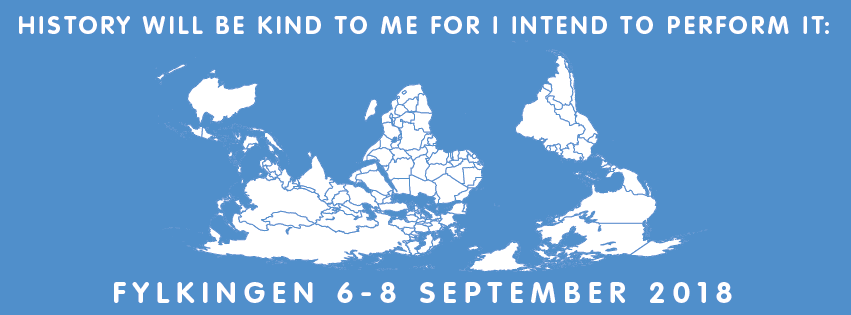 Nathalie Mba Bikoro (Gabon/Germany)
Nathalie Mba Bikoro (Gabon/Germany)
Valeria Montti Colque (Sweden)
Christian Etongo (Cameroon)
Serge Olivier Fokoua (Cameroon/Canada)
Diana Soria Hernandez (Finland/Mexico)
Anthea Moys (South Africa)
Gitte Sætre (Norway)
Gøril Wallin (Norway)
The festival is preceded by a two-day workshop An archive of my own/ Performing History led by artist Shiva Anoushirvani with:
Tanja Andersson
Diana Agunbiade-Kolawole
Louise Blad
Luanda Carneiro Jacoel
Angelica Falkeling
Mariusz Mateusz Andrzejczyk & Gabriella Novak
Jakob Niedziela
Karolina Oxelväg (STYRELSEN)
Elena Victoria Pastor Suarez
Rebecka Pershagen
Sara Sheikhi
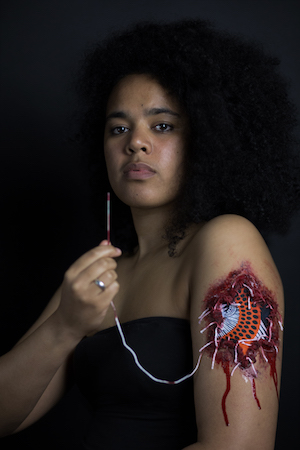 Mba Bikoro merges installations, sonic radio, live art performances, film & archives. Her work analyses processes of power & fictions in historical archives critically engaging in migrational struggles. She creates environments for untold narratives of resistance movements by African women and indigenous communities. Sedimented in narratives are testimonies of sonic nature archives, queering ecologies and postcolonial feminist experiences towards new monuments, reacting to the different tones of societies shared between delusions & ritual. She brings new investigations about the architectures of racisms in cities, the archeologies of urban spaces & economies of tradition systems by exposing the limitations of technologies as functional memory records. She has received several awards including Fondation Blachère & Afrique Soleil Mali for Best Artist Dakar Biennale (2012), IAPSIS Swedish Arts Council (2018), Arts Council England (2016) and Goethe Institut (2016).
Mba Bikoro merges installations, sonic radio, live art performances, film & archives. Her work analyses processes of power & fictions in historical archives critically engaging in migrational struggles. She creates environments for untold narratives of resistance movements by African women and indigenous communities. Sedimented in narratives are testimonies of sonic nature archives, queering ecologies and postcolonial feminist experiences towards new monuments, reacting to the different tones of societies shared between delusions & ritual. She brings new investigations about the architectures of racisms in cities, the archeologies of urban spaces & economies of tradition systems by exposing the limitations of technologies as functional memory records. She has received several awards including Fondation Blachère & Afrique Soleil Mali for Best Artist Dakar Biennale (2012), IAPSIS Swedish Arts Council (2018), Arts Council England (2016) and Goethe Institut (2016).
Nathalie Bikoro interviewed by Marcio Carvalho
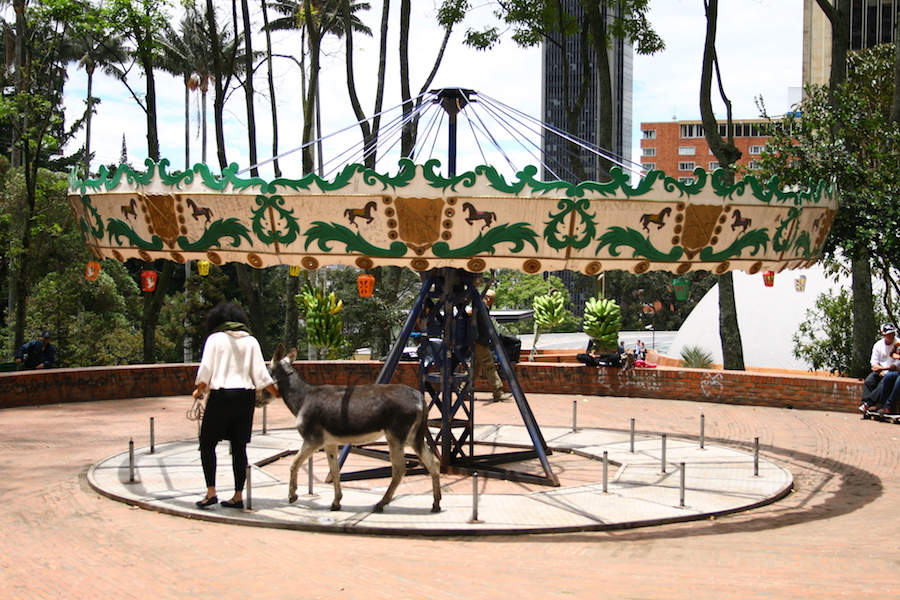
1. For Fanon, struggles for decolonization are first and foremost about self-ownership. They are struggles to repossess, to take back, if necessary by force that which is ours unconditionally and, as such, belong to us. What strategies you use in your art practice that might defy forms of knowledge, remembering and forgetting?
I would have a different positioning on this, as this is not exactly what Fanon tries to transmit in his statement. Fanon's writings have only been very recently translated and read within the academy for purpose to forge a critical language to reflect on today's society. However the work of repossession and violence that has been declared is anchored from a translated eurocentric positioning which doesn't reflect fully on Fanon's ideas from creolised French, experiences and purpose. Each of his books are evolutions also from observations specifically on Algerian colonisation and psychological condition taped through the knowledge of a French mixed Black man, he himself criticised his own views at times in lesser known journals and throughout many decades, his views have been challenged and contested by feminists writers like Marie-Chantal Kalisa.
The need to re-possess is the need for violence and for erasure and exclusion of any others; taking back that which is lost, taking back that that were already constructed myths created for us; the only thing that can belong to us is not a country but our shared imaginations.
What I do in my practice is a form of tender militancy that breaks the knowledge of what we have been given. The practice reflects on forms of monument-ing experiences through ephemeral conditions, cannibalising languages/processes of transmissions through biomythography and critical reflections on cultural appropriations. It is no longer about making images but about being inside of them. Mythology is the simultaneous act of forgetting and remembering which provides for me a space no longer of performativity but of magic. To decolonise we also have to forget about what we know as live art and performance, we have to learn and unlearn our own myths and stories, our own contours and this means according to Marimba Ba, becoming Griot. A political tool for healing through its own form of transmission enabling to trigger poetry and abstraction.
2. Today there is a gap between image and essence. Images they can distort the essence of a people, a place, a culture, etc, making them distorted, unworthy. Does your work try to restitute both, for better understandings of what lies behind stereotypes and epistemic colonialities?
Images are symbols of distortions, constructions and ideologies based on one person's vision, they can be violent, but it doesn't mean that they are not true. They are true because they reflect the vision and psychology of the message the person wanted to transmit, they are false because they do not reflect the voices and sensory realities of what is happening in the picture. Both are epistemic reflections on Eurocentric positions. The picture assures the story told by the oppressor not necessary the oppressed.
I don't destroy this in my work but what I can do is reflect on these positions and create spaces of engagement where you can learn how to read what you do not see, therefore make you see who you are, and in many cases audiences have an inability of self-reflection, an amnesia of their own identity because they are forged in spaces of privileged violence. We perform our own values of resistance and democracy but it doesn't mean that that democracy includes all the communities we try to reflect on.
My work is about emotion, connection, healing and apology. Often it means I have to forge the same system of violence endured in this "image" of western ideology/fantasy that will activate a frustration and denial. What I do within this task of performing is exactly how to read the picture, what is going on behind the picture that you cannot see, to unlearn and learn processes of emotions and allow a different possibility of ourselves and capabilities. Some may call it African, some may call it violent, witchcraft, magic but I am simply a storyteller who has an archive of experiences on her shoulders which reflect on our condition today. It is difficult to let go of that which we were given, it is difficult to react without imposing violence upon the other who tells you your story.
I don't restitute the 'true' of the image because often even our own traditions and images have been constructed for the purpose to dominate, control and colonise our people against our own, this is where Negritude doesn't work for me, the claim to come back, return to our 'authentic origins', i think the only thing we can return to is our memory based on touch, emotion, words that enabled us to survive and these can be forged by truths based on myths, transformations as well as distortions to protect those who were oppressed. We must not forget that colonisation is plural, it is based on the dominance and extermination of a population that have different sets of values or simply based on the idea of forging dominant races for political and economic purpose. Colonisation today is everywhere, women against women, black against black, white against white, every country I have been the history of colonisation was forged a long time before Europeans 'discovered' the world.
3. Today it's impossible to talk about knowledge without tapping into education. It seems that our education systems they became quiet obsolete in their pedagogies and their forms of knowledge. We still study based on Eurocentric views about the world, which in turn deprive students from a better understanding about the past and consequently a lack of tools to deal with and imagine many presents and futures still to come. What is your opinion about how academy is dealing with knowledge? And If you could use art, or art systems to decolonize the university and make it more pluriversity, and to re-invent the classroom, what would you do?
The limitations and risks for artistic practice stands on the relationship to power and class hierarchies that divide us. My approaches to education, history and and spatial strategies of reconfiguration and memory were encouraged in Brazil, South Africa and Senegal for example but banned and dismissed by university in Gabon as a way of provocation and propaganda against a very right-winged regime government.
To decolonise the classroom there is no one method or strategy it is a process of constant reinvention, passion, dedication and knowing how to be with people as groups and individuals. Knowledge loses its worth if you do not know how to transmit and teach to others, this is the consequence of most international educational systems North to South. The inability for connection and transmission. Knowledge are positions, forms of beliefs held by one or few groups which doesn't mean that they are true to all. Knowledge must be based on biomythographies, based on spaces, voices, interaction, sharing and self-care. Knowledge to be transmittable must be based on a science not based on exploitation of others or common sense measurabilities but exactly on the things we have lost, we cannot see, we cannot comprehend but on the constant building of truth, myth, poetry and fact, a science of the "griot", the one that must perform.
My method for the Eurocentric sceptic on education would be to challenge them to do the hard work, there is no instruction book on decolonising the classroom, it is based on those who have forged a life of experiences that those want to negate or those who have no comprehension of it based on their social privileges. The same way that there is no "repatriation" to forgetting the history of violence, genocide and colonisation, there is no one "method" for the classroom to decolonise. The classroom is a system, a space enforcing individuals to propose equal status whilst in fact they come all from different systems of experiences and what decolonisation can do is provide a nutrition, a re-adaptation on finding your own voice, protection and terrain. It would be impossible to give an instruction book of decolonial methods, our tools of emancipation should not be used and abused by neighbouring oppressors who might be inclined to forge privatisations and capitalisation over material that is meant to heal and provide safe spaces. The space of the academy has seen no changes but popularisation of violence; they were able to include material not to teach or transmit them into active active knowledge but as tools to maximise capital profits and therefore change structures of education into public capitalistic spaces written and spoken by professors that often have no anchors in the experience of what it is to be Black for example.
The academy is not the space that will decolonise the classroom, but the movement and interaction between international students who bring new knowledges, memory and experiences have been the compound for pushing and deconstructing the systems of violence in education.
Part of the challenges of the academy is who is able to enter inside it and who can get appropriately paid. Often professors and old administrative systems will slow the process of change and will hijack knowledge of others without finding tools or purpose to critically transmit material to their students. Now in reflection to politics and based on the depending economy brought by international students into Northern countries, universities are obliged to act on "diversity", but as Sarah Ahmed mentions, this idea of diversity is based on uncritical and eurocentric position to serve the purpose of increased economy and not on the knowledge transferred in the classroom. Ahmed reflects how too often academy maintains systems of violence, racism and ignorance by not allowing any protection and safety to their students when faced with abuse, statistically highest against POC students. Hence her strategy for decolonisation is what she calls resignation. In my years teaching in the academy in England notably and elsewhere, abuse is re-occurrent and is not dealt with according to the law.
What has decolonised the classroom in recent years, were POC students' complaints to the academies that forced the universities having to let practitioners like myself enter the classroom. What the students demand will become important to forge futures of their own narratives and archives. As long as power relations exists in the classroom between students based on their privileges and the teachers it will never be integral to the methods of practical decolonial artistic processes.
For international practitioners my advice would be to transmit our knowledge through a strategy that Fanon would call a "virus", creating an anti-biotic culture through cannibalist dissonant archives. Fanon suggests that an anti-biotic culture is a revolt, makes a change of bodily processes necessary as a means of anti-dote against dissonant social structures. Therefore body in motions must create a virus as an antidote against cognitive dissonance, marginalisation, invisibility and epistemologies of exclusion. The cognitive processes in performance use existing archives to generate new mythologies based on unacknowledged histories and loss. In perform-ing that which we do not see or what we do not want to know, we activate relations between communities, we activate plural anthologies, we activate memories for means of visible language and an antibiotic social historical re-positioning.
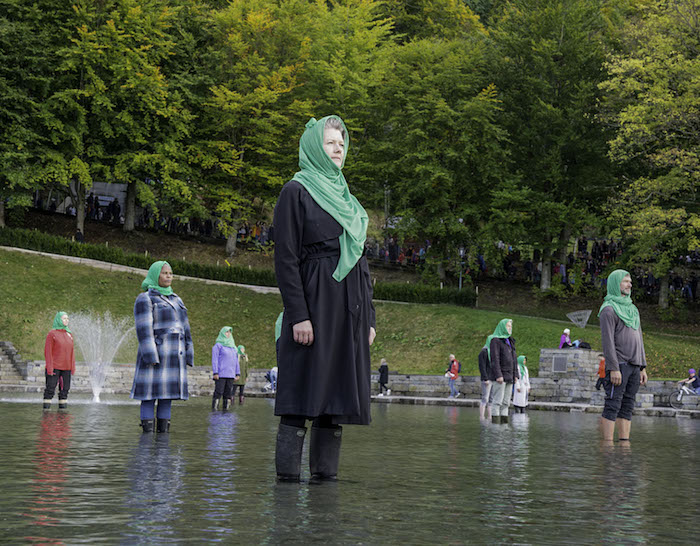 Gitte Sætre is a multidisciplinary artist, working with dialogue-based art, performance, photography, video and sound. Sætre's oeuvre deals with current and relevant issues, such as climate change, neoliberal ideological patterns, as well as cultural radicalism. Her body of work is characterized by the weight of contemporary society, yet opening room for humor and quiet reflection.Her work investigates roles and positions through generations, related to philosophical questions like forgiveness, guilt and freedom within the close family sphere, and into the sphere of national and international politics.
Gitte Sætre is a multidisciplinary artist, working with dialogue-based art, performance, photography, video and sound. Sætre's oeuvre deals with current and relevant issues, such as climate change, neoliberal ideological patterns, as well as cultural radicalism. Her body of work is characterized by the weight of contemporary society, yet opening room for humor and quiet reflection.Her work investigates roles and positions through generations, related to philosophical questions like forgiveness, guilt and freedom within the close family sphere, and into the sphere of national and international politics.
Interview with Gitte Sætre.
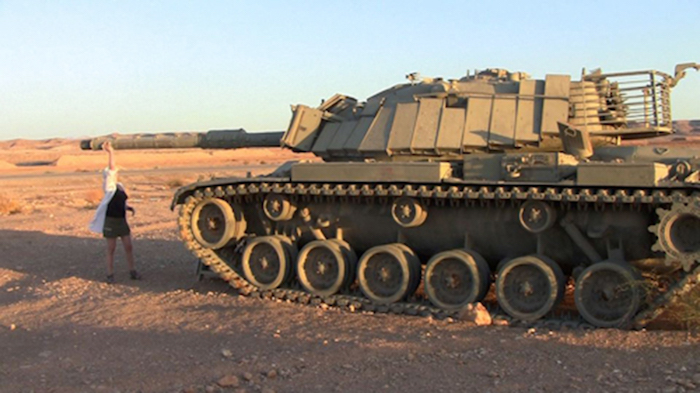
You often work with time-based art. Do have any thoughts about that, in comparison with, for example, art that is more object-based?
Since 2009 I have moved more or less away from object-based art due to political and practical reasons. I aim to be in a direct and acute dialogue with my surroundings. Time-based art makes the production period shorter and the budgets lower. This format challenges my daily presence and in many ways matches my temperament and interest/visions for art.
Are you working with any particular themes or issues in your practice at this time?
I explore the potential and possibilities for participatory creativity to help go beyond the crisis of the future within the projects: Green Hijab Movement, Magic of Seven and Soups&Stories.
In the projects Woman Cleaning and Mothers Dust, I explore the potential and possibilities to act on behalf of oneself.
In the other projects, I simply explore arts potential as a way of thinking out loud.
Can you share thoughts about your participation in History Will Be Kind to Me, for I Intend to Perform It -project? Did this project open up a new mode of investigation for you, or was it already part of your methodology? To be more specific, the project has a very concrete problematic, is this a new way of working for you?
The invitation to participate came only a few days after I started to work on a text very much relating to decolonization and the notion of demystifying knowledge production. So, I said yes in order to use the opportunity to speed up my thinking. I have for the last year been working on a project within this methodology, it is called Green Hijab Movement. My plan is to produce a new performance within the manifest of Green Hijab Movement. It feels safe and a bit unsafe at the same time. Something which I find to be a good starting point.
And I find it interesting to do it in a country like Sweden.
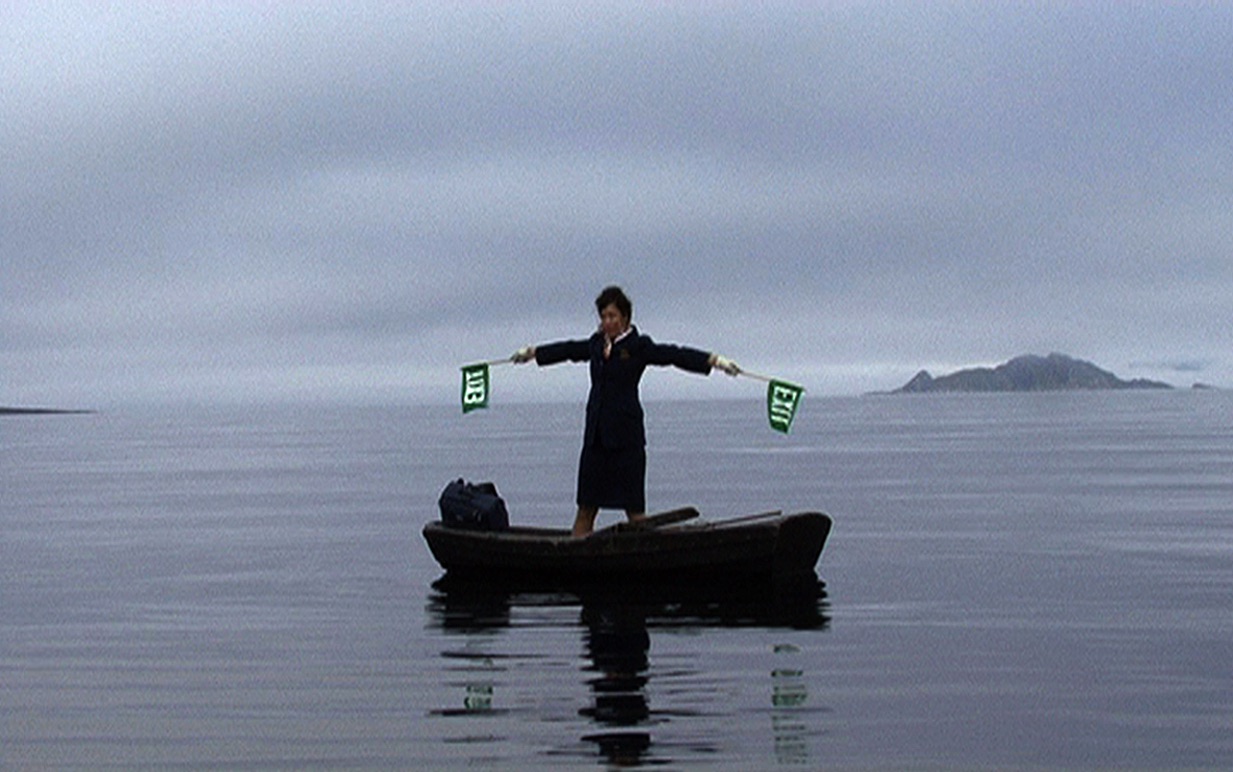 Gøril Wallin lives and works in Bergen, Norway. She is graduated from Bergen Academy of Art and Design. She works in fields of performance, video, photo, installation and costume/scenography. Themes in her works is often existential perspectives and emotions related to fear and security, often with a humorous element. Power, powerlessness, individual and collective, are other themes she find interested to investigate.
Gøril Wallin lives and works in Bergen, Norway. She is graduated from Bergen Academy of Art and Design. She works in fields of performance, video, photo, installation and costume/scenography. Themes in her works is often existential perspectives and emotions related to fear and security, often with a humorous element. Power, powerlessness, individual and collective, are other themes she find interested to investigate.
Interview with Gøril Wallin
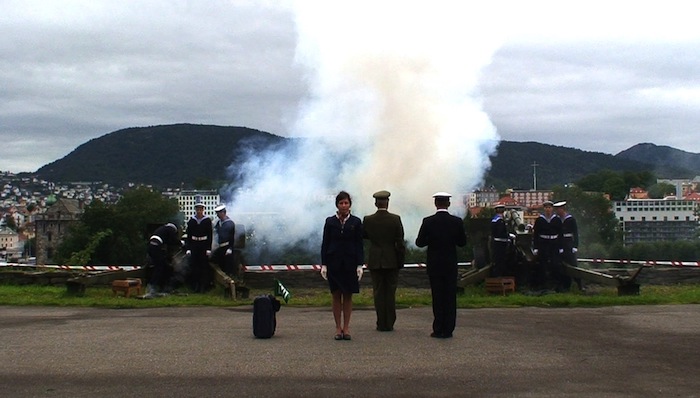
You often work with time-based art. Do have any thoughts about that, in comparison with, for example, art that is more object-based?
Time based art is different from object based art, because it’s more connected with being alive. It is in movement, and in change over time. You experience with your physical body. Body in space, body in time. Your sensory apparatus is activated, simultaneously with your thoughts. What happens, happens here and now. The context is the «real» world, the public room, with all it includes. The meeting with the people is unpredictable, everything can happen. You are not in control. Risk is included, and you are vulnerable. You explore borders both in relation to yourself and in relation to the outside world. You also have the possibility to make things happen; influence, sympathise, protest, discuss, ask questions (directly or indirectly).
Are you working with any particular themes or issues in your practice at this time?
One of the issues I´m concerned with is the way we are separate and alienated from the nature as human beings.We are living more and more closer to the virtual world.
Can you share thoughts about your participation in History Will Be Kind to Me, for I Intend to Perform It -project? Did this project open up a new mode of investigation for you, or was it already part of your methodology? To be more specific, the project has a very concrete problematic, is this a new way of working for you?
Through my participation in the projectI have got an opportunity to explore a theme that I otherwise would not do. By having a common theme, that several people work with at the same time, there will be different approaches to the theme. What I also like, is that the project is crossing borders, and involve different countries during a long period of time. The project is unpredictable and in progress, and will take shape during the journey. The meeting the other participants will be very important, and can be a common inspiration for how the project will develop together.
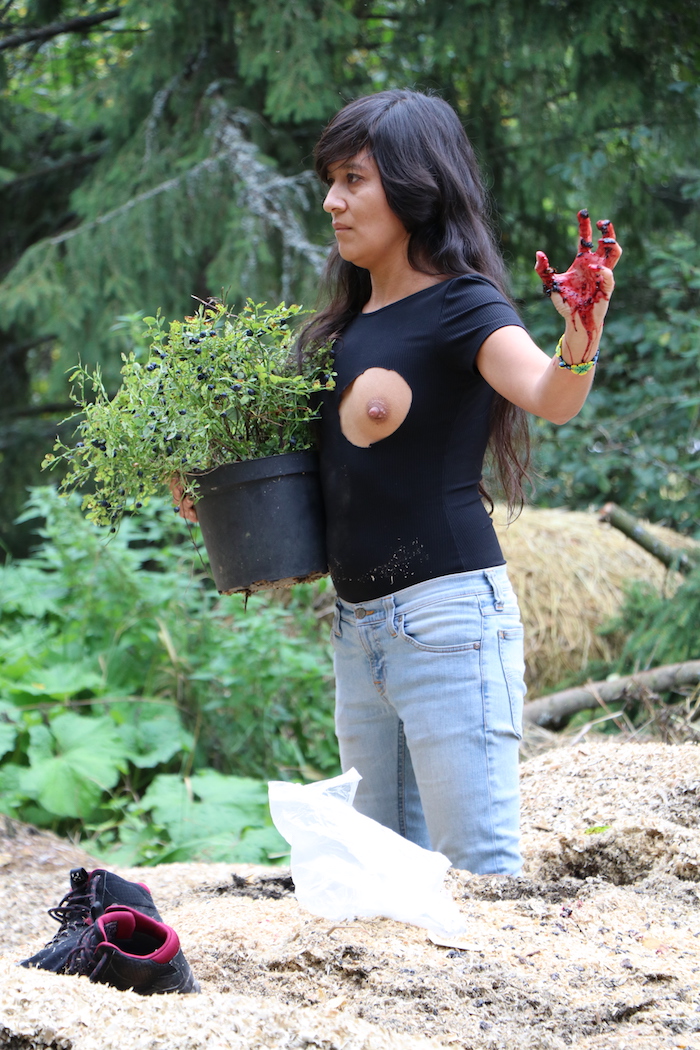 Diana Soria Hernandez (b. 1983, Mexico) is an independent artist focused on the exploration of visual and corporeal language mainly through performance art but also by using video, live installations, printmaking and drawing. She studied her BA in Fine Arts at La Esmeralda in Mexico, an MFA in Printmaking by the Academy of Fine Arts Helsinki and is pursuing a MA in Live Art and Performance Studies at the Theater Academy Helsinki, both belonging to the University of the Arts, Helsinki.
Diana Soria Hernandez (b. 1983, Mexico) is an independent artist focused on the exploration of visual and corporeal language mainly through performance art but also by using video, live installations, printmaking and drawing. She studied her BA in Fine Arts at La Esmeralda in Mexico, an MFA in Printmaking by the Academy of Fine Arts Helsinki and is pursuing a MA in Live Art and Performance Studies at the Theater Academy Helsinki, both belonging to the University of the Arts, Helsinki.
Her work has been shown internationally in exhibitions and festivals in Sweden, Finland, Germany, Spain, Cyprus, England, Mexico, Colombia and China. Her practice includes self-organized events as an effort to contextualize and expand views on Performance Art between Latin America and Finland. In 2017 she founded PROYECTO ANALCO as the platform to develop this path, supported by Kone Foundation (2016) and the Finnish Cultural Foundation (2018). Currently she lives and works in Finland and Mexico.
Diana Soria Hernandez interviewed by Leena Kela
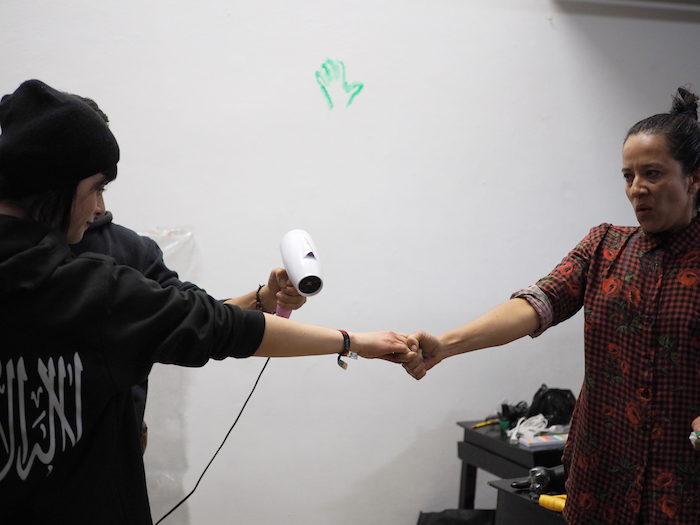
You are an artist whose work also operates in the field of activism. How would you introduce your artistic work and approach? What is your relation to decolonial thinking and practices?
For me decolonial thinking is rebellious and resilient, therefore it is a persistent practice. It starts as a collective practice that happens locally, among those with who we share context and history, because there is not one decolonial way of thinking (or theory) that can comprehend the immense work decolonial practices require.
For me, decolonial thinking is like a process of deconstruction that needs us to slow down and from a bird perspective start questioning and dialoguing, who we have been, who we are and what we want to be. At times it might not seem polite or diplomatic, it might be uncomfortable, but that's how changes take place.
At the moment, I'm especially interested in following thinkers that talk from the Latin American perspective and it helps much to continue this dialogue by making questions together with family, friends and colleagues that are close to the same experience. In this way we can thinking collectively who we have been, who we are and what we want to be.
My performance practice is drawn into reaching for the intangible while remaining as open as possible. My focus on deconstruction is a way of exploring the capacity of renewing associations and thoughts, of opening new perspectives. In a way I'm interested in the impossible, therefore I have become more abstract and more far away from wanting to deliver a message. I see more potential in this, more possibilities to affect but I'm still far away from what I would like to reach in my practice.
I am interested in the potential of simple and maybe even minimal gestures, elements, actions and languages that can evoke and transform reality, even if it happens for a moment. Consciously working with my human scale in relation to audience, geographies and media, I seek for an art that can break the inertia of paralysis or maybe even apathy and boredom.
What I consider my work in the micro politics scale is to evoke the absent, the (in)visibility of bodies (not only human) and bring it in palpable form, not by creating illustrations but instead in echoing something similar to a memory, something that can be experienced.
I have been also very interested in the limitations and possibilities of representation when it comes to conflict events or violence, and I have questioned if it is possible to represent violence without reproducing it.
You are from Mexico, but you have been living in Finland now for many years. When I got to know you around four years ago, you were working with a project that dealt with the disappearance of over 40 students in Mexico. Could you tell shortly about that project and how did you work with the topic? Did the physical distance to the origin of the event bring another perspective to the project?
My thesis work for my MA in Live and Performance Art was motivated by urgency. It was a reaction to the enforced disappearance of 43 rural school teachers from Ayotzinapa, Mexico on September 2014. When the event happened, an international movement started demanding justice and clarification of the involvement of federal police and Mexican government, it was a movement that could not be contained and that exposed internationally the levels of corruption and impunity in the country. For us who mobilised it was an opportunity to make pressure and seek for a change.
My work was driven this urgency. In the beginning it was not the theme of my thesis work, because I didn't even consider it art as such, it was more an exploration of performance as a tool for demonstration, for visibilizing, for adding up something as citizen. It became my thesis subject by itself, because it took over, because I was unable to do anything else. As a human experience, the physical distance to the origin of the event was very frustrating. It felt like a historical moment were things were changing, and I wanted to be there, nevertheless the possibility of working for it from Finland brought other possibilities and also responsibilities. My position in Finland gave me the responsibility of visibilizing the event here.
In artistic terms, the distance between Mexico and Finland revealed that language was insufficient and narratives were simplified and dismissed quickly. I made many performances that "failed" in delivering a message and this made me rethink and explore in different layers. I had understood that while living in the translocation, I had to think about representation and symbolic language in a much more abstract ways, hoping that through action, body and presence, I could evoke the fragility of giving visibility to a matter that had already been hyper exploited, alienated and banalised by the media.
So to finish answering the question, being in Finland back then, brought my only perspective on the event, it changed my language and made me question representation. I want to make an art that can recall a feeling, not that transmits a message.
What can performance art do? You have also been studying printmaking and worked as a visual artist. What made you to choose performance art as your main medium?
When I was studying printmaking I reached the point where someone recommended me to check performance art because my understanding of printmaking, even if it was experimental, had gone a bit too far. I didn't have the problem in defining if I was doing printmaking or not, but eventually I had to define it for others and so, I started new studies in Live Art and Performance Studies. Nevertheless the conceptuality of printmaking, remained. I insist even today that printmaking is much closer to performance than other traditional visual art disciplines.
Printmaking made me aware of reproduction/repetition, time, the mechanics of the body, the production of image, it gave me the sensation of making what nowadays I would call durational performances. These attributes of printmaking are still with me todays as I make mainly performance art, but with the clear distinction that performance art is action, is alive. Maybe this is the reason why I'm not so interested in making performance for camera, because after being a printmaker, creating images that can be captured and contained, is limiting. Printmaking, as other visual arts, are exhibited when finished and framed, and this was always bit frustrating to me.
The liveness of performance, its relation to time, context, space, audience, presence; blends into life, it has the potential of transformation. The apparent lack of a specific skill is also a gift for performance art, since it can surprise by creating layers and depth on the everyday life. I am interested and in need of immediate affection.
Performance art can create a utopian moment, a situation through affects and relationships. It is a language in itself that requires constant awareness and a fast mind. It interacts with the present, which is always unknown until its past. Because of this, for me performance can be art or a tool, as it was for me back in 2014, but it can come much closer to real life than any other art discipline. At the moment I'm interested in developing my performance art practice, and from there, I can address the micro politics.
